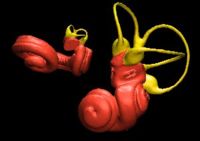Nature Engineers Perfect Balance

While most of our body parts continue their evolutionary quest for improvement, the portion of our inner ear responsible for balance may already have achieved perfection.
From whales to mice, nearly all 45,000 species of vertebrates have identically engineered semicircular canals, SCC's. Independent of species, the canals are all between 1 and 4 millimeters in size. A millimeter is about the thickness of a dime.
A new study found that changing the dimensions of the tiny structures diminished the organ's response.
"If I asked you to build the most sensitive semicircular canal possible, obeying certain physical and physiological constraints, then it turns out you would build it pretty much the same size that all vertebrates have," said Todd Squires, a physicist at Caltech.
A 2002 study found semicircular canals in whales and dolphins are smaller than in mammals of comparable size. This graphic compares a dolphin inner ear (left) with a bushbaby. The semicircular canals are shown in yellow. Credit: Fred Spoor, University College London
The three tiny loops of the canal structure detect movement from the sloshing of fluid within them. That in turn stimulates hair cells inside the canals that provide the brain with the information necessary to maintain balance.
Because sensitivity seems to be the most important requirement of the structure, Squires believes Nature has evolved the canals to be the best at what they were designed to do.
"Eventually, you could imagine that evolution might actually reach an "optimal" design -which is what I propose to have happened with the SCC," Squires said. "The SCC cannot scale with the size of the organism without sacrificing sensitivity or functionality."
Get the world’s most fascinating discoveries delivered straight to your inbox.
The research, detailed in the Nov. 5 issue of the journal Physical Review Letters, is one of the few studies to specifically think of evolution as an engineer, according to Squires, and then critique the process on its success.
As with all rules, however, there is an exception, and in this case it is sharks. When nearly all vertebrates follow the same template, sharks have a semicircular canal much bigger than the others.
"Sharks, for whatever reason, have an SCC ten times larger than the rest of us, and it seems they broke off the evolutionary tree very early," said Squires, who hopes to look at the reasons for this difference in future research. "This is tremendously speculative, but it is possible sharks use a different building material."
The exception aside, Squires believes the uniformity of the canals that sense rotation and thereby provides balance was able to develop early and to a superior level because its role is so specified and confined.
"This system has a very clear and limited purpose," Squires said. "Its whole purpose is just to sense rotation, and the more sensitive it is the better a sensor."
Nature has learned at what size that sensor is most responsive, according to Squires, and is sticking with what works, whatever the size of the animal that surrounds this optimal design.
- How We Hear: Mystery Unraveled


